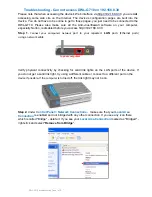
ESR service routers. ESR-Series. Functionality description. Version 1.12.0
174
•
•
•
•
•
Step
Description
Command
Keys
9
Set a list of keys for authentication
(optional).
esr(config-isis)#
authentication area key
chain <KEYCHAIN>
<KEYCHAIN> – key list identifier, set
by the string of up to 16 characters.
10
Enable transmission of router
name to the LSP (optional).
esr(config-isis)#
hostname dynamic
11
Set the IS-IS process operating
level (optional).
esr(config-isis)# is-
type {<LEVEL>}
<LEVEL> – IS-IS protocol operation
level:
level-1 – operate only on level
1;
level-1-2 – operate on levels 1
and 2;
level-2-only – operate only on
level 2.
12
Set the type of metric to be used
in the IS-IS process (optional).
esr(config-
isis)# metric-style
{ narrow | wide |
transition } [<LEVEL>]
narrow — accepts and generates
TLVs (on network reachability) of the
old type;
wide — accepts and generates TLVs
(on network reachability) of the new
type;
transition — accepts and generates
TLVs (on network reachability) of the
new and old type;
<LEVEL> – IS-IS protocol operation
level:
level-1 – operate only on level
1;
level-2-only – operate only on
level 2.
13
Set the route priority for the
specified IS-IS process (optional).
esr(config-
isis)# preference
{<VALUE>}
<VALUE> – may take values [1..255].
14
Enable IS-IS operation with IPv4
and/or IPv6 addresses (optional).
esr(config-isis)#
address-family { ipv4 |
ipv6 }
ipv4 – IPv4 family;
ipv6 – IPv6 family.
















































